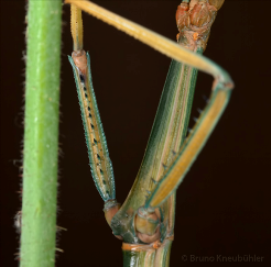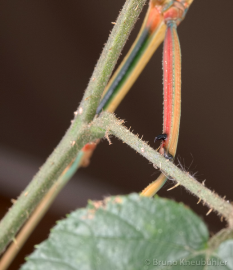
Form & Function
The Megaphasma detricus contains many features that make the species unique and adapted to their environment. MacRae expressed the size of the giant walking stick reaching over 150 mm long, with the females usually growing larger than the males (MacRae 2009). Arment describes Megaphasma detricus being a brown color with yellow or grey tint as well. The head is “smooth, rounded, and subvertical” (Arment 2006). The length of the antennae is double the size of the femora on the front legs of the walking stick. The femora on both the middle and hind legs contain spines. However, the spines on the females are smaller and placed in a line. The males have one bulky spine on the femora instead (Maginnis 2008). According to Maginnis in 2008, the function of these spines is to blend in against predators. Another function may be due to evolution where the males evolved larger spines compared to the females known as sexual dimorphism (Maginnis 2008).
The giant walking stick has another important and helpful way to defend themselves against predators. Similar to certain types of lizards and other insects, the Megaphasma detricus will lose their legs to escape from predators. MacRae found that the central nervous system plays a key role in the loss of their legs due to predators. Not only can Megaphasma detricus lose these limbs, but they can regrow them as well (Broyles 2000).
The Megaphasma detricus do not move too often but when they do the movements are cautious. Based on MacRae’s findings in 2009, the giant walking sticks appear to move back and forth in the wind to resemble twigs in their habitat. Most of the time the walking sticks will remain stationary, which makes them hard to come across (Wilkins 1951). A factor that separates the Megaphasma detricus from other walking sticks is the many rows of teeth that are located near the large antennae (MacRae 2009).



